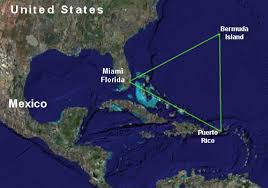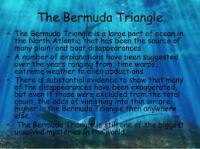The Mystery of Bermuda Triangle
 The Bermuda Triangle, also known as the Devil’s Triangle, is a loosely-defined region in the western part of the North Atlantic Ocean, where a number of aircraft and ships are said to have disappeared under mysterious circumstances. Most reputable sources dismiss the idea that there is any mystery. The vicinity of the Bermuda Triangle is one of the most heavily traveled shipping lanes in the world, with ships frequently crossing through it for ports in the Americas, Europe, and the Caribbean islands. Cruise ships and pleasure craft regularly sail through the region, and commercial and private aircraft routinely fly over it.
The Bermuda Triangle, also known as the Devil’s Triangle, is a loosely-defined region in the western part of the North Atlantic Ocean, where a number of aircraft and ships are said to have disappeared under mysterious circumstances. Most reputable sources dismiss the idea that there is any mystery. The vicinity of the Bermuda Triangle is one of the most heavily traveled shipping lanes in the world, with ships frequently crossing through it for ports in the Americas, Europe, and the Caribbean islands. Cruise ships and pleasure craft regularly sail through the region, and commercial and private aircraft routinely fly over it.
Popular culture has attributed various disappearances to the paranormal or activity by extraterrestrial beings. Documented evidence indicates that a significant percentage of the incidents were spurious, inaccurately reported, or embellished by later authors.
Triangle area
In 1964, Vincent Gaddis wrote in the pulp magazine Argosy of the boundaries of the Bermuda Triangle:[1] three vertices, in Miami, Florida peninsula, in San Juan, Puerto Rico, and in the mid-Atlantic island of Bermuda. Subsequent writers did not necessarily follow this definition.[2] Some writers gave different boundaries and vertices to the triangle, with the total area varying from 1,300,000 to 3,900,000 km2 (500,000 to 1,510,000 sq mi).[2] Consequently, the determination of which accidents occurred inside the triangle depends on which writer reported them.[2] The United States Board on Geographic Names does not recognize the Bermuda Triangle.[2]
Origins
The earliest suggestion of unusual disappearances in the Bermuda area appeared in a September 17, 1950 article published in The Miami Herald (Associated Press)[3] by Edward Van Winkle Jones.[4] Two years later, Fate magazine published “Sea Mystery at Our Back Door”,[5] a short article by George X. Sand covering the loss of several planes and ships, including the loss of Flight 19, a group of five U.S. Navy Grumman TBM Avenger torpedo bombers on a training mission. Sand’s article was the first to lay out the now-familiar triangular area where the losses took place. Flight 19 alone would be covered again in the April 1962 issue of American Legion magazine.[6] In it, author Allan W. Eckert wrote that the flight leader had been heard saying, “We are entering white water, nothing seems right. We don’t know where we are, the water is green, no white.” He also wrote that officials at the Navy board of inquiry stated that the planes “flew off to Mars.”[7] Sand’s article was the first to suggest a supernatural element to the Flight 19 incident. In the February 1964 issue of Argosy, Vincent Gaddis’ article “The Deadly Bermuda Triangle” argued that Flight 19 and other disappearances were part of a pattern of strange events in the region.[1] The next year, Gaddis expanded this article into a book, Invisible Horizons.[8]
Others would follow with their own works, elaborating on Gaddis’ ideas: John Wallace Spencer (Limbo of the Lost, 1969, repr. 1973);[9] Charles Berlitz (The Bermuda Triangle, 1974);[10] Richard Winer (The Devil’s Triangle, 1974),[11] and many others, all keeping to some of the same supernatural elements outlined by Eckert.[12]
Criticism of the concept
Larry Kusche
Lawrence David Kusche, author of The Bermuda Triangle Mystery: Solved (1975)[13] argued that many claims of Gaddis and subsequent writers were often exaggerated, dubious or unverifiable. Kusche’s research revealed a number of inaccuracies and inconsistencies between Berlitz’s accounts and statements from eyewitnesses, participants, and others involved in the initial incidents. Kusche noted cases where pertinent information went unreported, such as the disappearance of round-the-world yachtsman Donald Crowhurst, which Berlitz had presented as a mystery, despite clear evidence to the contrary. Another example was the ore-carrier recounted by Berlitz as lost without trace three days out of an Atlantic port when it had been lost three days out of a port with the same name in the Pacific Ocean. Kusche also argued that a large percentage of the incidents that sparked allegations of the Triangle’s mysterious influence actually occurred well outside it. Often his research was simple: he would review period newspapers of the dates of reported incidents and find reports on possibly relevant events like unusual weather, that were never mentioned in the disappearance stories.
Kusche concluded that:
- The number of ships and aircraft reported missing in the area was not significantly greater, proportionally speaking, than in any other part of the ocean.
- In an area frequented by tropical cyclones, the number of disappearances that did occur were, for the most part, neither disproportionate, unlikely, nor mysterious.
- Furthermore, Berlitz and other writers would often fail to mention such storms or even represent the disappearance as having happened in calm conditions when meteorological records clearly contradict this.
- The numbers themselves had been exaggerated by sloppy research. A boat’s disappearance, for example, would be reported, but its eventual (if belated) return to port may not have been.
- Some disappearances had, in fact, never happened. One plane crash was said to have taken place in 1937 off Daytona Beach, Florida, in front of hundreds of witnesses; a check of the local papers revealed nothing.[citation needed]
- The legend of the Bermuda Triangle is a manufactured mystery, perpetuated by writers who either purposely or unknowingly made use of misconceptions, faulty reasoning, and sensationalism.[13]
In a 2013 study, the World Wide Fund for Nature identified the world’s 10 most dangerous waters for shipping, but the Bermuda Triangle was not among them.[14][15]
Further responses
When the UK Channel 4 television program The Bermuda Triangle (1992)[16] was being produced by John Simmons of Geofilms for the Equinox series, the marine insurance market Lloyd’s of London was asked if an unusually large number of ships had sunk in the Bermuda Triangle area. Lloyd’s determined that large numbers of ships had not sunk there.[17] Lloyd’s does not charge higher rates for passing through this area. United States Coast Guard records confirm their conclusion. In fact, the number of supposed disappearances is relatively insignificant considering the number of ships and aircraft that pass through on a regular basis.[13]
The Coast Guard is also officially skeptical of the Triangle, noting that they collect and publish, through their inquiries, much documentation contradicting many of the incidents written about by the Triangle authors. In one such incident involving the 1972 explosion and sinking of the tanker SS V. A. Fogg, the Coast Guard photographed the wreck and recovered several bodies,[18] in contrast with one Triangle author’s claim that all the bodies had vanished, with the exception of the captain, who was found sitting in his cabin at his desk, clutching a coffee cup.[9] In addition, V. A. Fogg sank off the coast of Texas, nowhere near the commonly accepted boundaries of the Triangle.
The NOVA/Horizon episode The Case of the Bermuda Triangle, aired on June 27, 1976, was highly critical, stating that “When we’ve gone back to the original sources or the people involved, the mystery evaporates. Science does not have to answer questions about the Triangle because those questions are not valid in the first place … Ships and planes behave in the Triangle the same way they behave everywhere else in the world.”[19]
Skeptical researchers, such as Ernest Taves[20] and Barry Singer,[21] have noted how mysteries and the paranormal are very popular and profitable. This has led to the production of vast amounts of material on topics such as the Bermuda Triangle. They were able to show that some of the pro-paranormal material is often misleading or inaccurate, but its producers continue to market it. Accordingly, they have claimed that the market is biased in favor of books, TV specials, and other media that support the Triangle mystery, and against well-researched material if it espouses a skeptical viewpoint.
Reference:https://en.wikipedia.org/wiki/Bermuda_Triangle
First blog post
This is your very first post. Click the Edit link to modify or delete it, or start a new post. If you like, use this post to tell readers why you started this blog and what you plan to do with it.

